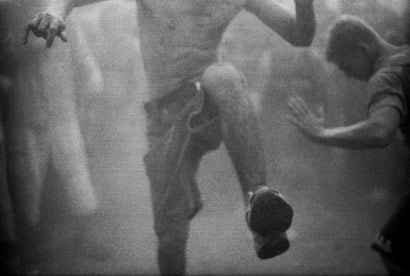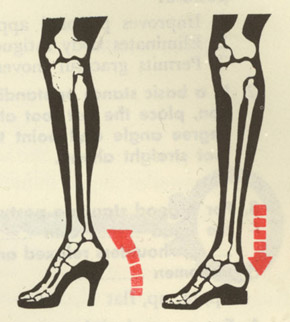ideas

Theorists have studied Prisoner’s Dilemma for decades, using it as a model for the emergence of co-operation in nature. This work has had a profound impact on disciplines such as economics, evolutionary biology and, of course, game theory itself. The new result will have impact in all these areas and more. […]
The game is this: imagine Alice and Bob have committed a crime and are arrested. The police offer each one a deal–snitch and you go free while your friend does 6 months in jail. If both Alice and Bob snitch, they both get 3 months in jail. If they both remain silent, they both get one month in jail for a lesser offence.
What should Alice and Bob do?
If they co-operate, they both spend only one month in jail. Nevertheless, in a single game, the best strategy is to snitch because it guarantees that you don’t get the maximum jail term.
However, the game gets more interesting when played in repeated rounds because players who have been betrayed in one round have the chance to get their own back in the next iteration.
Until now, everyone thought the best strategy in iterative prisoner’s dilemma was to copy your opponents behaviour in the previous round. This tit-for-tat approach guarantees that you both spend the same time in jail.
That conclusion was based on decades of computer simulations and a certain blind faith in the symmetry of the solution.
So the news that there are other strategies that allow one player to not only beat the other but to determine their time in jail is nothing short of revolutionary.
{ The Physics arXiv Blog | Continue reading }
ideas | August 19th, 2012 12:20 pm

When Nietzsche says, as he frequently does, that “the truth is terrible” he has in mind three kinds of terrible truths: (1) the terrible “existential” truths about the human situation (the inevitability of death and suffering); (2) the terrible “moral” truth that “life is essentially something amoral”; and (3) the terrible “epistemic” truth that most of what we think we know about the world around us is illusory.
These terrible truths raise Schopenhauer’s question: why continue living at all? Nietzsche’s answer, from early in his career to the very end, is that only viewed in terms of aesthetic values can life itself be “justified” (where “justification” really means restoring an affective attachment to life).
{ Brian Leiter /SSRN | Continue reading }
artwork { Rodolfo Loaiza }
ideas, nietzsche | August 17th, 2012 4:42 pm
Back in 2009, The Millions started its “Difficult Books” series–devoted to identifying the hardest and most frustrating books ever written, as well as what made them so hard and frustrating. The two curators, Emily Colette Wilkinson and Garth Risk Hallberg, have selected the most difficult of the most difficult. […]
To The Lighthouse by Virginia Woolf - In its intermingling of separate consciousnesses, Virginia Woolf’s fiction is both intellectually and psychically difficult. Not only is it hard to tell who’s who and who’s saying or thinking what, it is also disconcerting—even queasy-making—to be set adrift in other minds, with their private rhythms and associative patterns. It feels, at times, like being occupied by an alien consciousness. […]
Women & Men by Joseph McElroy - In this space I could put any number of postmodern meganovels - a subgenre I’ve been smitten with for many years now. There’s William Gaddis’ JR, which is easier than people make it out to be, and Pynchon’s Gravity’s Rainbow, which is harder. There’s The Recognitions and Mason & Dixon. There’s William H. Gass’ The Tunnel - verbally lucid, but morally arduous. Of the lot, though, I’d like to shine the spotlight again on Joseph McElroy’s Women & Men. It is longer than any of the foregoing, and, in the idiosyncracies of its prose, on par with the hardest. Parts of it, anyway. Its temperament, though, is completely sui generis - warm, humanist, synthetic rather than analytic.
{ Publishers Weekly | Continue reading }
books | August 17th, 2012 4:22 pm

Every day, crucial business and political decisions are made on the basis of numerical data. Only rarely do the key decision makers produce that data; rather they rely on others, not only to produce it, but to present it to them. Yet how many quants – the data producers – know how to present data effectively? To put it another way, how many of them know how to tell a story using numbers?
{ Devlin’s Angle | Continue reading }
ideas, mathematics | August 17th, 2012 4:21 pm

Crowdsourcing is basically what it sounds like: posing a question or asking for help from a large group of people. Coined as a term in 2006, crowdsourcing has taken off in the internet era. Think of Wikipedia, and its thousands of unpaid contributors, now vastly larger than the Encyclopedia Britannica.
Crowdsourcing has allowed many problems to be solved that would be impossible for experts alone. Astronomers rely on an army of volunteers to scan for new galaxies. At climateprediction.net, citizens have linked their home computers to yield more than a hundred million hours of climate modeling; it’s the world’s largest forecasting experiment.
But what if experts didn’t simply ask the crowd to donate time or answer questions? What if the crowd was asked to decide what questions to ask in the first place?
Could the crowd itself be the expert?
That’s what a team at the University of Vermont decided to explore — and the answer seems to be yes.
{ University of Vermont | Continue reading }
ideas | August 15th, 2012 8:10 am

Whether or not certain crime syndicates control illegal markets, or both the legitimate and illegitimate business activities in a neighborhood, a town or even a region, is an important question in scholarly discussions of organized crime. In the early 1970s, American scholars such as Donald Cressey and Thomas Schelling identified monopolistic control of this kind as one of the defining features of organized crime. In the words of Schelling, “real organized crime is striving to control the underworld.”
The notion that “mafia-type” criminal organizations dominate criminal markets and even succeed in regulating the activities of other criminal groups immediately met with fierce criticism from the criminology world. Various researchers who had studied the American drug and gambling markets failed to find Cosa Nostra or any other crime syndicate in control of these illegal activities. Peter Reuter, for example, concluded that the mafia did not dominate the New York illegal gambling market. Instead, it was “disorganized” and made up of many independent criminal groups of varying sizes competing for market share. This powerful image is now widely thought to describe how criminal markets are structured in states with a functional legal system, the assumption being that criminal groups cannot grow “big” under constant law enforcement pressure.
{ SSRN | Continue reading }
economics, ideas | August 12th, 2012 2:26 pm

There is still controversy over whether war is a science or an art. Efforts to define war as entirely a science have failed. Scientific methods are essential in explaining what occurs in war, and business models aid in managing military organization, planning forces, and designing weapons. Quantifying has its place, but these methods are less suitable as one approaches the operational and strategic levels. A knowledge and understanding of war must be based on science, but its actual conduct is largely an art. Scientific and technological advances will not change that reality. The character of war may alter substantially, yet its nature in the Clausewitzian sense will remain. Seeking to make war simple, predictable, and thus controllable will collapse under the larger weight of such intangibles as the human factor and the psychological elements, which will always ensure there is a fog of war. […]
Carl von Clausewitz (1780–1831) warned that so-called mathematical factors can never find a firm basis in military calculations. In his view, war most closely resembles a game of cards. […]
The most dramatic changes in military theory that led to a more refined view of warfare occurred in Germany in the late 18th and early 19th centuries. The major cultural trends in Germany were romanticism, nationalism, and idealism. German romanticism challenged the fundamentals of the French-dominated Enlightenment’s worldview. It was opposed to the French cultural and political imperialism. It led to the awakening of German national sentiment. German thinkers of the “counter-Enlightenment” believed that concepts of knowledge and reality are fundamentally false, or at least exaggerated. For them, the world was not simple but highly complex, composed of innumerable and unique elements and events, and always in a state of flux. […]
Clausewitz believed only in broad generalities, none of which consistently held true in the fog and friction of actual combat. […]
The principal psychological features of any war are hatred, hostility, violence, uncertainty (or fog of war), friction, fear, danger, irrationality, chance, and luck. For Clausewitz, a war was a trinity composed of primordial violence, hatred, and enmity—a blind natural force. […] He pointed out that the only situation a commander can know fully is his own. […]
Clausewitzian views on the true nature of war remain valid today. The human element is the single most critical aspect of warfare. Human nature has changed little despite vast changes in military technologies. Warfare is too complex and unpredictable an activity to be taken over by machines or explained and managed by pseudoscientific theories. Only the human brain is fully capable of reacting in a timely and proper fashion to the sudden and unanticipated changes in the situation and countering the enemy’s actions and reactions. The enemy has his own will. He can react unpredictably or irrationally.
{ Milan Vego/National Defense University Press | Continue reading }
fights, ideas | August 12th, 2012 8:11 am

Quantum computer scientists believe quantum computers can solve problems that are intractable for conventional computers. It’s not that quantum computers are like regular computers, but smaller and faster. Rather, quantum computers work according to principles entirely different than conventional computers, and using those principles can solve problems whose solution will never be feasible on a conventional computer.
In everyday life, all our experience is with objects which can be directly simulated by a conventional computer. We don’t usually think about this fact, but movie-makers rely on it, and we take it for granted – special effects are basically just rough computer simulations of events that would be more expensive for the movie makers to create in real life than they are to simulate inside a computer. Much more detailed simulations are used by companies like Boeing to test designs for their latest aircraft, and by Intel to test designs for their latest chips. Everything you’ve ever seen or done in your life – driving a car, walking in the park, cooking a meal – all these actions can be directly simulated using a conventional computer. […]
Now, imagine for the sake of argument that I could give you a simple, concrete explanation of how quantum computers work. If that explanation were truly correct, then it would mean we could use conventional computers to simulate all the elements in a quantum computer, giving us a way to solve those supposedly intractable problems I mentioned earlier. […] Quantum computers cannot be explained in simple concrete terms; if they could be, quantum computers could be directly simulated on conventional computers, and quantum computing would offer no advantage over such computers. […]
Quantum computers work by exploiting what is called “quantum parallelism”. The idea is that a quantum computer can simultaneously explore many possible solutions to a problem. Implicitly, such accounts promise that it’s then possible to pick out the correct solution to the problem, and that it’s this which makes quantum computers tick. […] The problem comes in the second part of the story: picking out the correct solution.
{ Michael Nielsen | Continue reading }
ideas, technology | August 12th, 2012 8:10 am

Top actors, writers, and athletes have agents, who help them find good jobs, in exchange for a small part of their income. But having an agent is pretty rare – why don’t the rest of us have agents?
You might think its only worth paying an agent 5% of your income for jobs where wages vary by large factors, and that most people’s wages are pretty much set by their occupation, education, etc. Not true, however. Consider: workers in the same occupation, with the same observable experience, school, etc. can easily earn 30% more, or 30% less, just based on the industry they work in. For example, in the auto industry both janitors and truck drivers make twice the salary of janitors and truck drivers in the “eating and drinking place” industry.
{ Overcoming Bias | Continue reading }
economics, ideas | August 6th, 2012 4:15 pm

Although real ‘clock measured’ time is passing at a constant rate, experience tells us that our subjective sense of the amount of time that has occurred, or the speed at which time is passing, can vary, leading to distortions in the passage of time. When we feel like less time has occurred than actually has, time feels like it has speeded up. When we feel like more has occurred than actually has, time feels like it has slowed down.
Despite being commonly experienced, the mechanisms behind distortions of the passage of time are underresearched and, as a result, poorly understood. Anecdotal accounts imply that our experience of time is influenced by our emotions and the activities we engage in: ‘time flies when you’re having fun’, but not when an car is hurtling towards you.
It is not only enjoyment and fear that affect how quickly time appears to be passing: other alterations in subjective consciousness have similar effects. The consumption of drugs and alcohol has long been known to warp time experiences. […]
Having experienced distortions in the passage of time whilst under the influence of drugs and alcohol, there is some concern amongst users about whether any effects could be permanent. Heavy drug and alcohol use can result in long-term neurological damage (Harper, 2009) and impaired cognitive function (Fisk & Montgomery, 2009), both of which may alter timing ability even when drug use has ceased. Chronic cocaine and amphetamine use reduces dopamine D2 receptor availability (Volkow et al., 2001), and, because animal studies have demonstrated that dopamine levels influence duration perception, it is possible that chronic users of cocaine or methamphetamine may show impaired timing even after drug use has stopped.
{ The Psychologist | Continue reading }
photo { Janine Gordon }
neurosciences, time | July 27th, 2012 3:18 pm

Arousal, the researchers contend, actually affects our perception of time. […]
The researchers presented 116 males with images from an online Victoria’s Secret catalog and gauged their response to receiving one of two fictitious Amazon.com promotions: a gift certificate available that day or one available three months from now. They asked the subjects the dollar value that would compensate for having to wait. Those exposed to sexually charged imagery (versus those in a control group exposed to nature images) were found to be more impatient and expressed that future discounts would have to be steeper to compensate for the time delay.
{ EurekAlert | Continue reading }
painting { Willem Drost }
marketing, psychology, sex-oriented, time | July 27th, 2012 3:10 pm

They might say that sex between people who are in love is special (maybe even sacred), but they also know sex is part of the partnership of getting through life together and has to be considered pragmatically as well. Even people in love do not have identical physical and emotional needs, with the result that sex takes different forms and means more or less on different occasions. […]
Part of the mythology of love promises that loving couples will always want and enjoy sex together, unproblematically, freely and loyally. But most people know that couples are multi-faceted partnerships, sex together being only one facet, and that those involved very often tire of sex with each other. Although skeptics say today’s high divorce rate shows the love-myth is a lie, others say the problem is that lovers aren’t able or willing to do the work necessary to stay together and survive personal, economic and professional changes. Some of this work may well be sexual. In some partnerships where the spark has gone, partners grant each other the freedom to have sex with others, or pay others to spice up their own sex lives (as a couple or separately). This can take the form of a polyamorous project, with open contracts; as swinging, where couples play with others together; as polygamy or temporary marriage; as cheating or betrayal; or as paying for sex. […]
Many people, not just professional sex workers, know that the work of sex can mean allowing the other to take an active role and assuming a passive one as well as taking the active role or switching back and forth. Sometimes people do what they already know they like, and sometimes they experiment. Sometimes people don’t know what they want, or want to be surprised, or to lose control.
For some critics, the possession of money by clients gives them absolute power over workers and therefore means that equality is impossible.
{ Jacobin | Continue reading }
photo { Tim Geoghegan }
economics, ideas, relationships, sex-oriented | July 26th, 2012 9:49 am

Single-Nostril Navigational Reliance in Pigeons
We recorded the flight tracks of pigeons with previous homing experience equipped with a GPS data logger and released from an unfamiliar location with the right or the left nostril occluded. The analysis of the tracks revealed that the flight path of the birds with the right nostril occluded was more tortuous than that of unmanipulated controls. Moreover, the pigeons smelling with the left nostril interrupted their journey significantly more frequently and displayed more exploratory activity than the control birds, e.g. during flights around a stopover site.
[…]
How Randomly Selected Legislators Can Improve Parliament Efficiency
Democracies would be better off if they chose some of their politicians at random. That’s the word, mathematically obtained, from the Catanians’ extension of their random research, using insights they gleaned from the much earlier stupidity work by Cipolla.
Parliamentary voting behavior echoes, in a surprisingly detailed mathematical sense. Cipolla had sketched this in the “Basic Laws of Human Stupidity.” Cipolla gave an insulting, yet possibly accurate, description of any human group: “human beings fall into four basic categories: the helpless, the intelligent, the bandit, and the stupid.” Pluchino, Rapisarda, Garofalo and their colleagues base their mathematical model partly on this fourfold distinction.
{ Annals of Improbable Research | full issue }
photo { Daniel Seung Lee }
birds, ideas, science | July 26th, 2012 9:48 am

Self-citing is often frowned upon, being considered (and sometimes is) vanity, egotism or an attempt in self-advertising. However, everyone self-cite because sooner or later, everyone builds upon previous findings. “Given the cumulative nature of the production of new knowledge, self-citations constitute a natural part of the communication process.” (Costas et al., 2010).
The argument whether citation analysis should include self-citation has been going on since the early days of citation analysis and is still ongoing. Early citation studies tended to exclude self-citation, but today’s Journal Impact Factor (JIF) includes them. […]
We’ve seen that self-citation can pay off at the journal level, but what about individual authors? Fowler and Aksnes (2007) did another research on the Norwegian database, but this time it was author rather than publication oriented. The percentage of author self-citation was rather low – 11% – but every self-citation yield, on average, 3.65 citations from others in 10 years. Fowler and Aksnes concluded that “self-citation advertises not only the article in question, but the authors in question.”
{ Scientific American | Continue reading }
ideas | July 25th, 2012 1:36 pm

In general, the more different is the new environment from the old, the better it is to start over. Rigid things are fragile, in that they break when you try to bend them far.
This suggests that designed systems tend to get irreversibly fragile as they adapt to specific environments. When context changes greatly, it is usually easier to build new systems from “scratch,” than to un-adapt systems designed for other contexts. Software tends to “rot“, for example. […]
Today I’m focused on this being bad news for the feasibility of immortality, at least for human-like creatures. You see, our minds seem designed to adapt to the environment in which we grow up, via youthful plasticity transitioning to elderly rigidity. For example, we are great at learning languages when young, and terrible when old. We are similarly receptive when young to new ways to categorize and conceive of things, but once we have often used particular ways, we find it harder to understand and use alternatives.
The brains of most animals peak in functionality during their key reproductive years, and do worse both before and after. Short lived animals peak sooner than long lived animals. Some of the early rise is due to learning, and some of later decline is due to the decline of individual cells and connections. Some of this pattern may even be due to an explicit plan to turn up some dials on plasticity early on, and then turn down those dials later. But I think another important part of this rise and fall is due to a general robust tendency for adapted systems to slide from plasticity to rigidity.
{ Overcoming Bias | Continue reading }
photo { Joel Meyerowitz }
ideas, photogs | July 25th, 2012 12:06 pm

Confucianism is not a conceptual monolith but rather has a variety of traditions, versions and forms including imperial, reform, elite, merchant-house, and mass Confucianism. Just as Confucianism is multidimensional, democracy is also multifaceted including liberal, developmental, social, deliberative, and republican conceptions of democracy.The relationships between democracy and Confucianism therefore must be multiple and complex.
{ SSRN | Continue reading }
artwork { Sylvan Lionni }
ideas | July 25th, 2012 11:04 am

Does infinity exist?
This is a surprisingly ancient question. It was Aristotle who first introduced a clear distinction to help make sense of it. He distinguished between two varieties of infinity. One of them he called a potential infinity: this is the type of infinity that characterises an unending Universe or an unending list, for example the natural numbers 1,2,3,4,5,…, which go on forever. These are lists or expanses that have no end or boundary: you can never reach the end of all numbers by listing them, or the end of an unending universe by travelling in a spaceship. Aristotle was quite happy about these potential infinities, he recognised that they existed and they didn’t create any great scandal in his way of thinking about the Universe.
Aristotle distinguished potential infinities from what he called actual infinities. These would be something you could measure, something local, for example the density of a solid, or the brightness of a light, or the temperature of an object, becoming infinite at a particular place or time. You would be able to encounter this infinity locally in the Universe. Aristotle banned actual infinities: he said they couldn’t exist. This was bound up with his other belief, that there couldn’t be a perfect vacuum in nature. If there could, he believed you would be able to push and accelerate an object to infinite speed because it would encounter no resistance. […]
But in the world of mathematics things changed towards the end of the 19th century when the mathematician Georg Cantor developed a more subtle way of defining mathematical infinities. Cantor recognised that there was a smallest type of infinity: the unending list of natural numbers 1,2,3,4,5, … . He called this a countable infinity. […] This idea had some funny consequences. For example, the list of all even numbers is also a countable infinity. Intuitively you might think there are only half as many even numbers as natural numbers because that would be true for a finite list. But when the list becomes unending that is no longer true.
{ Plus | Continue reading | Other Plus articles on the subject of infinity }
photo { Thobias Fäldt }
ideas, mathematics | July 24th, 2012 5:07 pm

Every sect of Buddhism maintains that it is a religion of compassion and nonviolence. Throughout its history, however, Buddhism has occasionally been embroiled in warfare and military campaigns. Zen Buddhism in particular has managed to find its way into various military arts. From its incorporation into the Shaolin Monastery and the impact on the Japanese samurai to its absorption into the curriculum of several martial arts, Zen and fighting have come to be seen as closely related. This is due to certain characteristics of its doctrine as well as its practice. In fact, fighting is not entirely absent from Zen texts and literature. There are stories and kōans which depict amputations, encounters between samurai, or some kind of confrontation. Fighting, in the sense of an inner struggle is also present. […]
The objective of this examination is to draw parallels between Zen meditation and martial arts training and explore the reasons why Zen’s core philosophical doctrine and meditative practice can be integrated seamlessly into the martial arts.
{ SSRN | Continue reading }
fights, ideas, psychology | July 24th, 2012 5:00 pm

Smeesters published a different study in the Journal of Experimental Psychology suggesting that even manipulating colors such as blue and red can make us bend one way or another.
Except that apparently none of it is true. Last month, after being exposed by Uri Simonsohn at the University of Pennsylvania, Dr. Smeesters acknowledged manipulating his data, an admission that been the subject of fervent discussions in the scientific community. Dr. Smeesters has resigned from his position and his university has asked that the respective papers be retracted from the journals. The whole affair might be written off as one unfortunate case, except that, as Smeesters himself pointed out in his defense in Discover Magazine, the academic atmosphere in the social sciences, and particularly in psychology, effectively encourages such data manipulation to produce “statistically significant” outcomes.
{ Time | Continue reading }
image { Vaka Valo, DRXXM DXXRY }
ideas, psychology | July 22nd, 2012 10:21 am

Back in October 2008, just after the investment bank Lehman Brothers collapsed, the International Monetary Fund unveiled its forecasts for growth in 2009. The IMF is the global lender to national governments; its economic pronouncements are highly respected. So what did it predict? The US would grow 0.1% in 2009, countries in the euro zone 0.2% and the world as a whole 2.6%. The actual outturns were declines of 3.5%, 4.2% and 2.6% respectively.
This lamentable short-sightedness was not unique. […]
To be fair to economists, there are two reasons why their forecasts are often likely to be wrong. The first is that humans are not inanimate objects; we change our behaviour and we watch the news. If every economist forecast a recession for 2013 and the predictions were widely publicised, businesses would cancel their investment programmes and consumers would start saving, not spending, for fear of losing their jobs. The recession would occur now, not next year.
Second, the economy is a complex mechanism with many working parts. Economists cannot run real-time experiments in the same way as scientists; operating one version of the economy with high interest rates and another with low rates, as a pharmacologist can offer one patient a new drug and another a placebo. There is no way of isolating the various factors that affect growth.
But there are more fundamental questions about the nature of the subject beyond the failure of economists to make accurate forecasts.
{ Economist | Continue reading }
photo { Mathew Scott }
economics, ideas | July 22nd, 2012 10:11 am





















